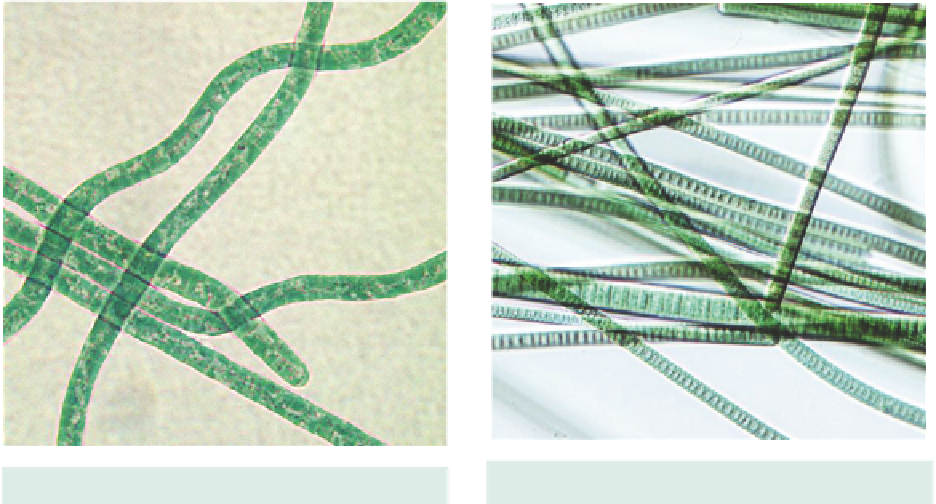Environmental Engineering Reference
In-Depth Information
40 μm
15 μm
Figure 4.29
Phormidium.
Detail from web of fila-
ments forming a dense algal mat. Reproduced with per-
mission from R. Matthews.
Figure 4.28
Lyngbya.
General view of tangled fila-
ments.
NB
. Cultured specimen does not show an obvious
sheath.
NB.
some genera, for example,
Botryococ-
cus
, have colonies that are densely stained
brown making it difficult to see cell contents,
especially chloroplasts. This can be made
easier by gently squashing the colony under
a coverslip to spread the cells out thus mak-
ing it easier to see the contents of individual
cells.
(b) Filaments interwoven in a sticky gelati-
nous matrix, sheaths of filaments become
indistinctandsticky.........
Phormidium
Phormidium
is extremely common on damp
soil, stones, rocks etc. or may be free-
floating. Trichomes are cylindrical, some-
times tapering slightly towards the ends, with
a firm thin sheath. Present within the gelati-
nous mass, they are capable of movement.
Cells, shorter than wide (0.6-12 μm wide,
1.0-10 μm long), may be constricted at the
cross-walls. The end cell of the filament is
oftencharacteristicofthespecies.Becauseof
the difficulty in seeing the sheath when pre-
served it can often be confused with
Oscil-
latoria.
Cyanophyta. Plate VII. Figs. 2.23,
2.29, and 4.29.
57
(56) (a) Epiphytic, unicellular or at the
most a few-celled colony in which
exospores are produced at the apical end
..........................
Chamaesiphon
Chamaesiphon
is epiphytic on other aquatic
plants sometimes forming dense aggregates
or colonies, also epilithic. Frequent in flow-
ing streams. Cells normally sausage or club-
shaped, sometimes curved, 10-50 μm long
and 2-7 μm wide. Cells usually surrounded
by a sheath which may be brownish in colour.
Exospores are produced at the apex of the
mothercellandarespherical2-9μmindiam-
eter, 5-70 μm long, and are produced in sin-
gle or multiple rows. Cyanophyta. Plate VII.
56
(3) (a) Cell pigments not localized in chloro-
plasts................................
57
(b) Cell pigments localized in chloroplasts
.....................................
68


Search WWH ::

Custom Search